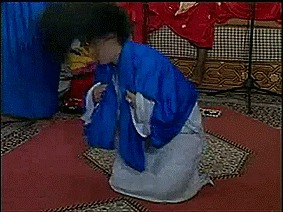
“We all have mluk inside us. You, me, everyone. But we don’t know.
When we get sick or when we attend a lila we learn about it.” — Moqademma Zaida Gania, 2007
(Music of the Gnawa of Morocco, pg. 89)
You have noticed throughout this series where women factor in Gnawa...

GNAWA AND
DIASPORIC AFRICAN POWER GNAWA
LIVE STREAM I (![]() )
GNAWA LIVE STREAM II
(
)
GNAWA LIVE STREAM II
(![]() )
GNAWA LIVE STREAM IV
(
)
GNAWA LIVE STREAM IV
(![]() )
GNAWA LIVE STREAM V (
)
GNAWA LIVE STREAM V (![]() )
)
GNAWA LIVE STREAM VI (![]() )
GNAWA LIVE STREAM VII (
)
GNAWA LIVE STREAM VII (![]() )
GNAWA LIVE STREAM VIII
(
)
GNAWA LIVE STREAM VIII
(![]() )
)
Haddarates of Essaouira (led by moqdemma Zaida Gania), Bnat
Gnawa, Asmaa Hamzaoui and
Bnat Timbouktou from
Casablanca, Bnat Houariyat, Houara
women of southern Morocco
who participate in Gnawa, Hasna el Becharia, Mimouna (we
honored on April 10)...
No matter their perceived
position in life, femmes have been present in Gnawa.
That is what hadra means: presence
(Traveling Spirit Masters, pg. 16).
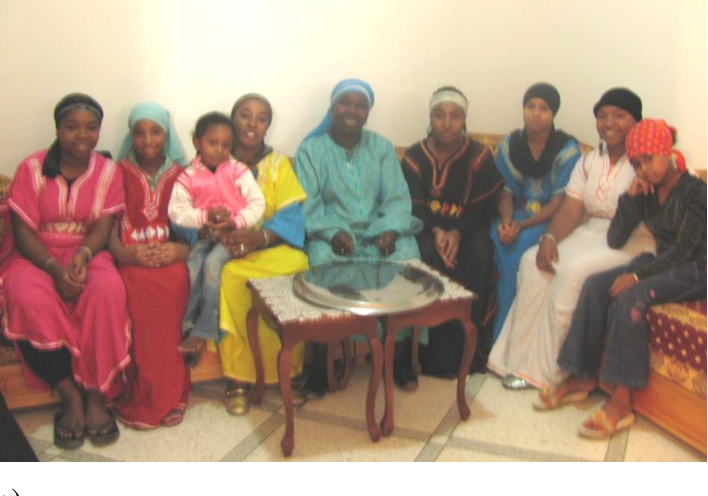
Moqademma Zaida Gania (center) with their seniya (instrumental plate),
daughters and nieces.
They are ancestrally Malian and Senegalese.
Photograph by Maisie Sum.
Gnawa Beliefs and History
Gnawa's roots reach toward Gao, Hausa,
Wolof centuries ago. And Kufan Kanawa
was a medieval site in Zinder.
Akal al-ignawen covers West African
lands from which Hausa, Soloke, Songhay
and Wodaabe communities came.
This is Salamatu Mai, a gurmi player from Nigeria,
playing a Gnawa prototype.
Gnawa went through Errachidia, Tinghir, Marrakech,
Taroudant, Agadir, Safi, Rabat, Fes and Meknes to Tangier.
"I met Gnawa who were 80 and 90
years old, who remember
were walking across the Sahara desert,"
Randy Weston said.
"They were creating this music; where
these rhythms come from.
Their instruments are basic instruments
we knew as a ginbiri." (Art Works)
The full ancestral Gnawa route is in Cities,
You could have a child with your master
and share the same faith,
yet again, it was no guarantee if they or you would be free (Black Morocco).
Gnawa women were subject to this and
other expectations as concubines and
participants in Moroccan patriarchy, from
research (The Calls of Islam, pg. 88).
Masters now transcend physical slavery
and that is historically contextual.
Gnawa songs refer to marabouts,
local saints plus al-mlouk, or
Gnawa's honored spirits who grant baraka, blessings from God.
'Ftouh Rahba' mirrors Moroccan souks that sold artisanal crafts,
fabric and grain by morning, then
enslaved Africans by the evening.
Now their journey uses night as a reversal.
Gnawis' metaphysical progression
with pre-existent memories
creates a complex, multi-generational conversation about race,
religion and existence itself in
Africa's overall history (Ganawa).
Islam and the definition of women's roles
by men does affect Morocco.
Yet agency has been passionately claimed
in Aissawa, Hamadsha, Gnawa.
Life beyond these sects may show more
dichotomy between gender and sex.
Here within Gnawa, far less separation exists.
Daughters learn possession dances,
how to conjure from their parents.
They play guembris like their fathers or uncles.
Lilas may be their first tangible memory.
Gnawiyas, Haddarat, Houariyat transform cosmogyny +
generational trauma into ceremonial healing.
Masru ("struck") is their first initiation from al-mlouk.
Meskun describes an occupied state, and rbet is the last stage:
complete connection with the other side. You can achieve
this as an adept after several years of practice.
MOQADEMMAS, ORIGINS AND SPIRITS
Moqademmas control spirits while controlled psychically by them.
There was only black earth, sea, night and the dunya in creation's beginning
as Gnawa belief narrates: a primeval serpent's egg whose yolk was
released by hajjaj, duelling whirlwinds.
Now there are seven earths and heavens, and seven colors of
al-mluk (Sanyassa) as well which are guided
by the guembri (The Nomadic Alternative). We will explain more later.
This sacred three-stringed lute is made from poplar wood, camel and goat parts,
a removable metal sersera with rings on its neck (Skyrock).
Cowhide lace ties together the alluring dual-headed qarqaba castanets.
All of these musical details relate to this backstory.
Gnawa nubat (musical suites) follow a specific, color-based order: treq.
Mira comes at sunrise, Mimoun precedes Chorafa, Lalla Aisha and the layalet.
There is danger and trangression if certain suites aren't remembered.
Sidi Smaa, Bacha Hamou, Bouhala and Moussa to Lallas Fatima and
Mimouna are just some spirits who may come to the rituals.
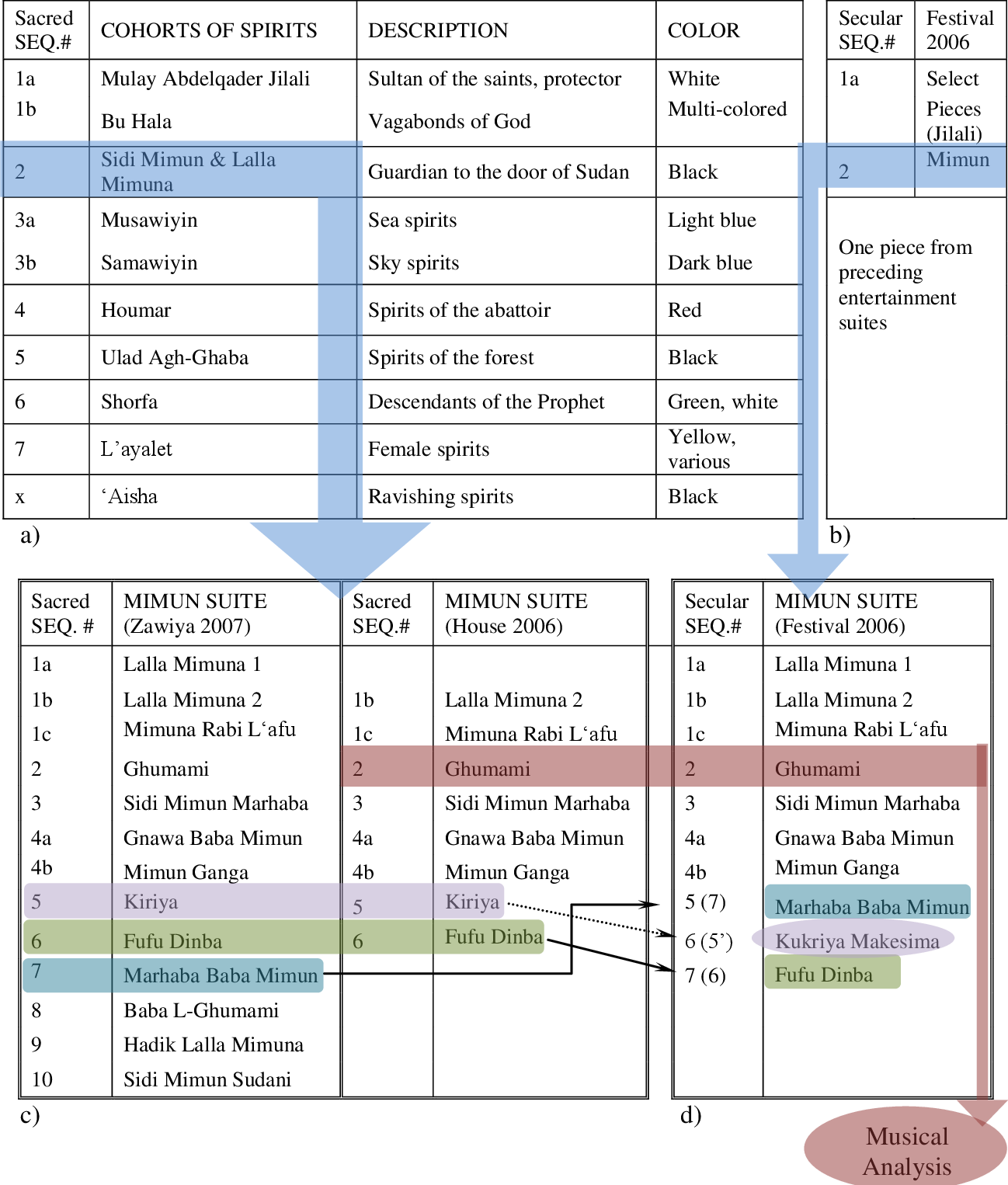
(Music
of the Gnawa of Morocco: Evolving Spaces and Times)
This changes. An 'ashiyya lasts until midnight, whereas lilas
will extend into the next morning or a three-day
derdeba we've mentioned (The Gnawa Lions).
Moussems are commonplace throughout the land.
The hard sahla and bendable tarra sticks echo a multi-faceted
rhythm from old African pasts (The Space of Africanness).
Such critical borrowing sewed together a fragmented identity
to make one whole. You see another example with Bouderbala,
a saint whose multi-patched robe featured all seven colors.
Gnawiyas undertake several stages of preparation.
The moqademmas arrange offerings and robes, sacrificial animals,
jawi (incense), food, candles or lamps and bkhur (herbs).
Maalems have a gasâa prepared for their first lilas as well,
though it's a rare custom nowadays.
This is done with special care, and especially during Shaa'ban,
Moulud or Ramadan (Muslim holidays that Gnawa observes)!
Sometimes women-only troupes perform beforehand.
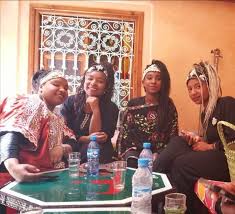
B'Nat Gania, Essaouira Gnawi musicians from Maalem Gania's family
Fraja (entertainment via acrobatic dance, games, mimicry
and naha'ir, sacrifice before dinner) has two halves:
Ouled Bambara, the descendants of Bambara and Negsha,
which is mysterious in its meaning. The altar is named mida.
Welcome to al-aada, or the beginning.
Women carry two candles to represent hajjaj, and a tabieka
or platter to attract any further attendees.
Before they enter the home or within it, henna
is applied to arms, feet and hands.
You can find this otherworldly
paste on many zawiyas,
which can be free to visit or only
visited during festival season.
Rooms with ceremonial garb,
ghensha (small bags for musical
replacements) are often only for women too.
Sometimes moqademmas will not
leave them until music is playing.
Essaouira's zawiya is the oldest sainthood
and dedicated to Sidi Bilal,
the Ethiopian muezzin who made the first adhan (Sanyassa).
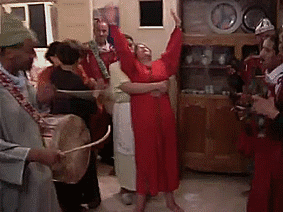
An adept during Al-Houmar, the red suite
They are rather well-experienced in this eerie, supernatural dialogue.
Maybe Sidi Chamharouch, al-mluk's leader,
will speak through the moqademma.
Tomorrow that voice may be Lalla Mimouna or Mira.
The Feminine Spirits (Al-Nisa')
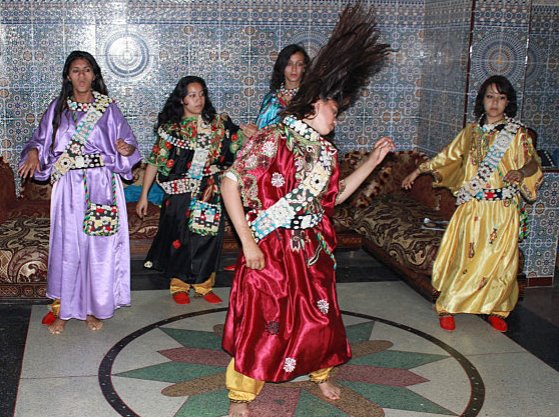
Tatla, to rise and sway during possession
LALLA AISHA
She is Lalla Mimouna's daughter, and the guardian over
thresholds but not necessarily the
Black Gate like Mimouna.
Lalla Aicha appreciates bounty like
her mother, and also is visited
at springs and sacred wells since Mimouna rescued a Gnawi.
This is a glossary of ritual items.
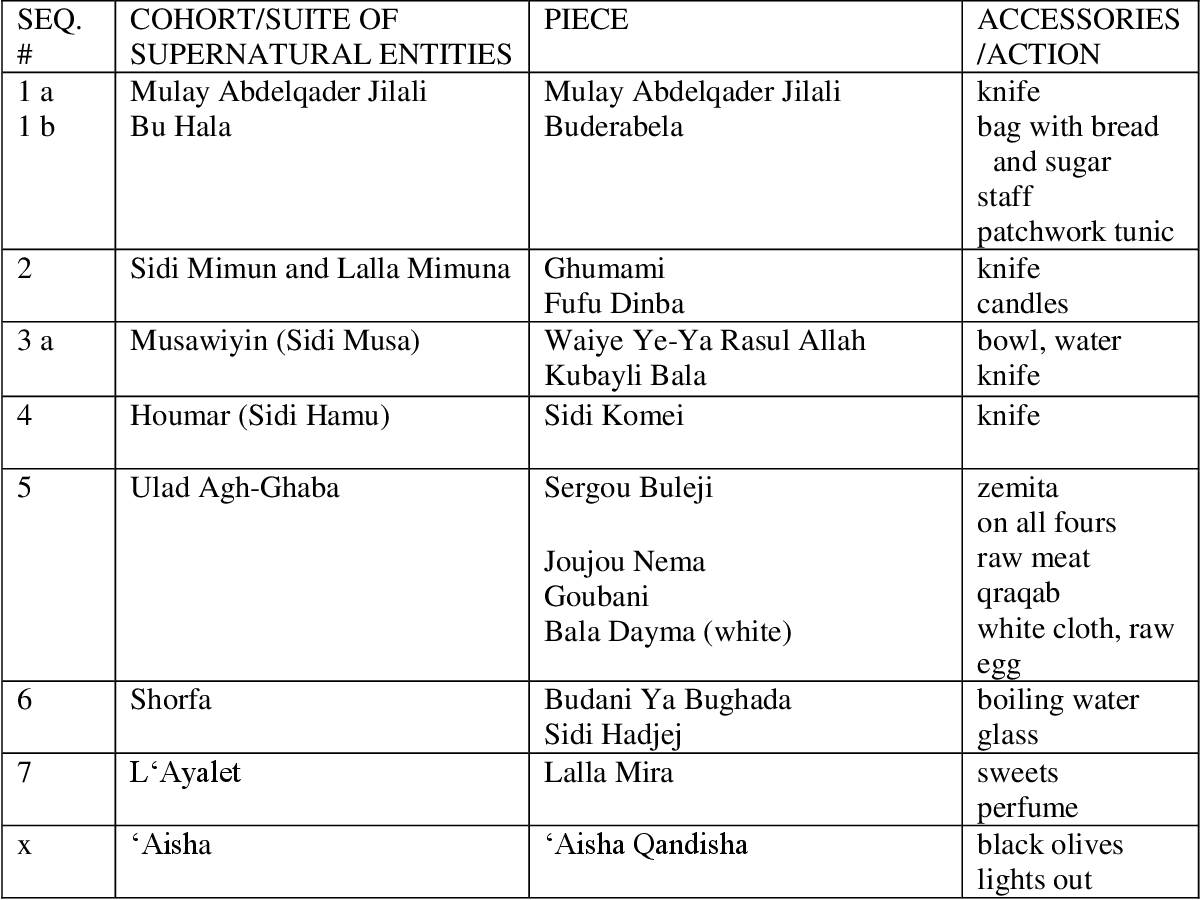
(Music
of the Gnawa of Morocco: Evolving Spaces and Times)
Chama Mechtaly is an Amazigh-Jewish
artivist and designer who gave us this precious insight.
"Some tell the story of how she saved a slave by showing up in
the middle of the Sahara desert and offering him a
water canteen when he was about to die of thirst.
The slave, who was inspired by
the sound of water in a
leather canteen, later created Gnaoua music and told
others the story of Mimouna, his savior.
Interestingly, Lalla Mimouna today
is a small village in the south of Morocco that was built
around a water source named after the saint...
Gnaoua musicians head to the village
of Lalla Mimouna every year
around the same time as Passover to pay their respect
to Lalla Mimouna’s spirit in
a three day pilgrimage.
Passover commemorates the journey from
spiritual slavery to spiritual freedom,
which is a central concept in Gnaoua music."
Yearly treks like these have been declining for a decade before this,
but Gnawa groups still want to preserve the tradition.
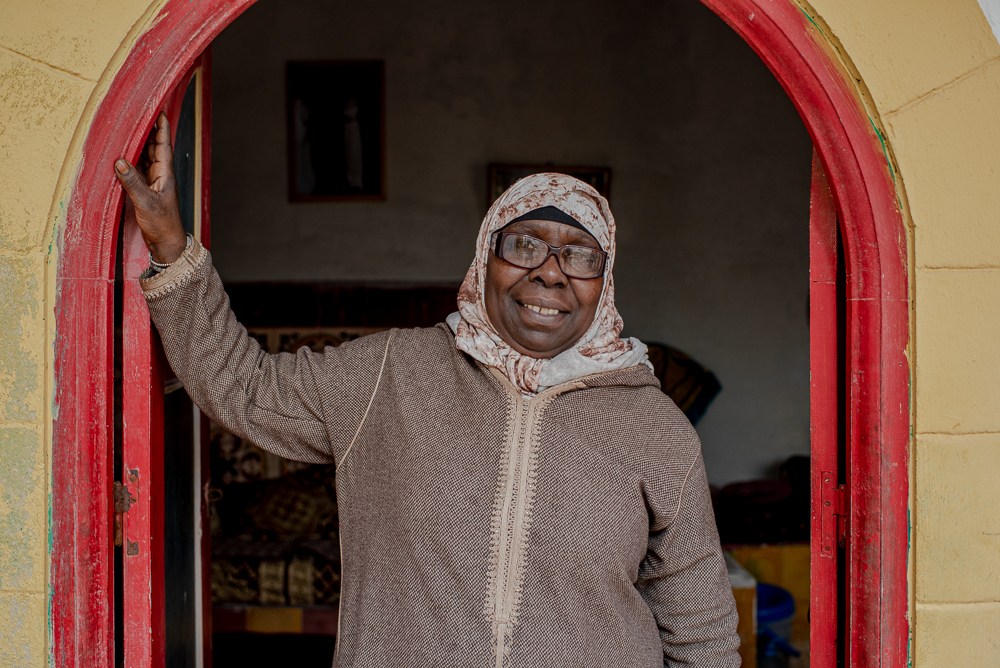
Moqademma Zaida Gania, Sidna Bilal's caretaker and Haddarat performer
"When I was a child there were countless Gnawa groups.
They came from everywhere.
The baraka was very strong.
I saw incredible things, but now it’s been scraped away.
There are only a few groups...”
(Music of the Gnawa of Morocco, pg. 87)
She's offered anise seeds, honey, olives,
black benzoin incense, etc.
Lalla Aisha could ask for symmetrically dotted henna patterns too.
Her shrine, l-hufra dyal ‘Aisha, ‘the grotto of ‘Aisha,’
is under a fig tree by Sidi ‘Ali ben Hamdouche's.
Followers wear multi-colored
robes, red or black.
Their suite (Gnawa and Diasporic
African Power) includes Aisha
El-Gnawiya, Aisha Hamduchia, Qandisha,
etc. (Moroccan Tape Stash).
Bnet Gnawa and Maalem Abdenbi el
Meknassi perform 'Aicha Soudania'.
There is multiplicity with Aisha, so why names
range from Al-Bahariyya and
Dghughiyya (a Hamadsha version)
to Kandisha or Soudania.
Moroccans have old legends of Aisha
Kandisha as a powerful priestess
or djinn of Amazigh origin who fended off European colonists.
LALLA FATIMA AND KHALIFA
Lalla Fatima Zohra, Prophet
Mohammed's daughter, is linked with
green and white since these are the Chorafa's colors.
The Chorafa suite features 'Laafou Ya
Moulana', holy saints Abdelkader
'Jilali' and 'Brahim', 'Hadiya' and more
LALLA MALIKA
Lalla Malika's colors are mauve or purple and
black (Skyrock). She is Fassi (from Fes),
flirtatious and Algerian Jewish royalty.
Malika has always been lavish, and the
eponymous song comes from
Tafilalt near the Moroccan-Algerian Sahara border
Henna, grape or raisin juice, lipstick,
mirrors and sandalwood
are some ritual items for her.
LALLA MIMOUNA
She has great respect as mother of Gnawa,
the door to Sudan or Black Africa.
Mimouna can allude to the Red Sea's
parting by his God-given power,
and this celebration of a Lady Luck (Tablet Mag).
Mimoun means 'fortune',
so we wanted to highlight an English excerpt/translation of 'Lalla
Mimouna' (link/translation of Darija).
"Here she comes, Lady Mimouna
Here she comes, Lady Fortuna
Bringing joy to all and sundry with her bounty
We never go hungry
Candies, cakes and drinks galore
Pleasure and gladness lie in store
Beloved Mimouna, Mimouna..."
'Ghumami' (Sidi Mimoun's form as
'the storm'), 'Sidi Muhammad
ya Suba3i', 'Mimoun ya Marhaba' and 'Mimouna'
are Lalla Aisha's repertoire.
Sidi Mimoun is her brother, they are a
main duo of the black suite.
Followers may use knives and bleed none at all.
She is offered daghnoo (like haroset),
spiced juices, honey, unsalted
and unleavened bread.
LALLA MIRA
Lalla Mira is a joyous, playful Amazigh queen who induces dance.
A follower Naghram relayed their first lila
while "struck" almost 20 years ago.
Their mlouk are the samawiyin now, but
listen to her encounter with Mira:
"I danced, danced, danced like a
mad woman...I passed out.
They put rosewater in my mouth and gave me incense."
Their items are eggs, henna, incense,
musk, rose water and sweets!
She requires no designs with her henna, just
the brightness on hands and feet.
The yellow suite is multi-colored, but
named because she rules this nubat.
LALLA RKIA/RQIYYA
This Marrakchi saint is summoned for healing and fertility (Angeetdam).
She is part of the red suite.
Enjoy the song by late Rabat Maalem Mohamed Chaouqi.
Gnawiyas Today
Hasna El Becharia broke ground as an Algerian
musician, unapologetic guembri player.
She was born in Gnawa's main birthplace: Bechar.
"The guembri and I have a bit of history.
My father was a Gnawa master and I wasn’t
allowed to touch this instrument.
When I dared to do so, I was beaten.
That’s why I left the guembri alone and started on the guitar.
It was only in 1999 that I finally came back to it
in France for the Women of Algeria festival.
I was invited, and it was only then that
I let myself play the guembri.
When I arrived in Paris, I dreamed of
my father saying: “Go ahead”...
These songs are almost like family for musicians
there in the Sahara, they grew up with them."
B'Net Houariyat have collaborated with everyone from Karim Ziad and Peter
Gabriel to Morocco's most beloved masters. This is Khadija with Maalem Belkani.
Bnet Gnawa and Maalem Abdenbi el Meknassi
were the first mainstream group
to feature women's Gnawa mastery in Morocco (Buala).
They have been a shining beacon
for change since 2011's debut.
Ancestral healing has traveled with
them from Meknes to Belgium.
Asmaa Hamzaoui leads Bnat Timbouktou in the Casaoui style
since 2012, with encouragement from father Maalem Rachid.
Marrakech maalem Mustapha Bakbou,
other esteemed musicians
and the world has come together to appreciate them.
"He may have not have a son, but he
loves the idea of being the first
Moroccan gnawa master to transmit his
teachings to a female performer.”
Hamzaoui is a fabulous leader with her
own feelings about the rise of
maalems, the popularity in that title across Gnawa music.
"There are too many people calling themselves
ma’alems these days, when they are not.
That cheapens the art. I feel that there should be an
institution set up of real masters, who can then
grade these artists and give them the title.
I am a long way from that." (The National)
We witness Gnawa's ever-evolving attitudes
about authenticity, acceptance.
It is so special to document over time.
Conservative attitudes about this didn't stop
the acceleration of a new era.
May Gnawa women and adepts continue to
promote freedom of their expression.
Saha, kokriya! You are vessels, storytellers,
defiant power-holders and spirit masters too.
The Gnawa Lions Gnawa: Music and Spirit Multicultural Morocco Of Love Between Saints and a Jinniya
The Space of Africanness: Using Gnawa Music in Morocco as Evidence of North African Slavery The Body In Remembrance: Dhikr In Moroccan Sufism Saints and Servants in Southern Morocco